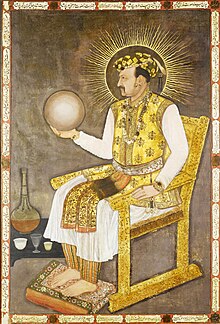
Nadiri


Nadiri was a type of a overcoat that was specifically reserved for the Mughal emperor Jahangir (r. 1605–1627) and his esteemed courtiers.[2][3] The vest was an invention of his own, which he had named 'Nadiri'.[4] Nadiri was known as kurdi among the people in Persia.[2][5] The term 'nadiri' was meant to refer to rarity.[6]

Style
The Nadiri is a sleeveless coat that extends down to the thighs and features buttons at the front.[7] It was traditionally worn over the Qaba, a long coat with sleeves and buttons.[7][8]

Jahangir's fashion and artistic interests
According to historical records, Jahangir had a passion for fashion and his attire, including his turbans and jewelry, and tended to be more extravagant and ornate compared to the fashion sense of his father Akbar's era.[3] Jahangir had a strong interest in art and architecture. He documented events, descriptions of flora and fauna, and daily life in his reign in his autobiography, the Jahangirnama. He also commissioned court painters like Ustad Mansur to create detailed artworks to accompany his writing.[9] Jahangir adorned himself with magnificent clothing crafted from intricate silks and brocades. In addition, he introduced a variety of new dresses, including the nadiri, which he reserved for those whom he chose to grant it to.[10]

Jahangir's fashion was closely monitored and emulated by the court. He issued a decree that specified certain textiles and garments to be made exclusively for his use. As a reward for their loyalty and service, the emperor bestowed selected courtiers with gifts of clothing and jewelry, including the nadiri that was designed by himself.[11]

As stated in the emperor's memoir, Jahangir had a unique outfit consisting of nadiri, tus shawl, batugiriban, qaba made of Gujarati satin, chera, and waist-belt woven with silk and gold threads, which he kept for himself.[12]

Jahangir holding a globe
Mughal paintings have elements from Central Asia and Europe as well as Persian and Indian styles and methods.[13] Mughal paintings spanning the 16th to 19th century depict various aspects of life during that period, including legendary tales, warfare, courtly activities, gardens, hunting, and wildlife.[14]

Jahangir is depicted here [in the above image] wearing magnificent court attire, including a patterned sleeveless jacket that he dubbed nadiri ('rarity'). He is wearing two patkas (sashes) around his waist: the longer one is intricately embroidered with gold floral designs, while the shorter one is made of Rajasthani tie-dye fabric.[15]

References
- ^ Crill, Rosemary; Jariwala, Kapil (2010). The Indian Portrait, 1560-1860. Mapin Publishing Pvt Ltd. ISBN 978-81-89995-37-9.
- ^ a b Umair Mirza (31 July 2021). Indian History - Collection of Indian History- Collection 7. p. 223.
- ^ a b Findly, Ellison Banks (25 March 1993). Nur Jahan: Empress of Mughal India. Oxford University Press. p. 221. ISBN 978-0-19-536060-8.
- ^ Koch, Ebba (2018), "Jahangir as Publius Scipio Maior", Portraiture in South Asia Since the Mughals, I.B. Tauris, doi:10.5040/9781350987579.ch-003, ISBN 978-1-83860-897-2, retrieved 28 April 2023
- ^ Goswamy, B. N. (1993). Indian Costumes in the Collection of the Calico Museum of Textiles. D.S. Mehta. p. 119.
- ^ Kumar, Ritu (2006). Costumes and Textiles of Royal India. Antique Collectors' Club. p. 40. ISBN 978-1-85149-509-2.
- ^ a b Sharma, Sunil (27 November 2017). Mughal Arcadia. Harvard University Press. doi:10.2307/j.ctvgd336. ISBN 978-0-674-98124-9.
- ^ Chaudhuri, K. N. (1990). Asia Before Europe: Economy and Civilisation of the Indian Ocean from the Rise of Islam to 1750. CUP Archive. p. 182. ISBN 978-0-521-31681-1.
- ^ Beach, Milo Cleveland (24 September 1992). Mughal and Rajput Painting. Cambridge University Press. pp. 89, 90. ISBN 978-0-521-40027-5.
- ^ Mohamed Nasr. Nur Jahan Empress of Mughal India. p. 63.
- ^ Dey, Gouri. Fashion And Designing Under The Mughals Akbar To Aurangzeb. A Historical Perspective. p. 138.
- ^ Mohamed Nasr. Mughal Costumes ( 16th 18th Century) And Royal Costumes. p. 129.
- ^ Asher, Catherine B. (31 July 2017). "Mughal Paintings: Art and Stories, The Cleveland Museum of Art. Edited by Sonya Rhie Quintanilla with Dominique DeLuca . London: D. Giles Limited, 2016. 386 pp., 400 color illustrations. ISBN: 9781907804892 (cloth)". The Journal of Asian Studies. 76 (3): 823–825. doi:10.1017/s0021911817000717. ISSN 0021-9118. S2CID 164872106.
- ^ Ali, Azmat; Sahni, Janmejay; Sharma, Mohit; Sharma, Prajjwal; Goel, Dr Priya (12 November 2019). IAS Mains Paper 1 Indian Heritage & Culture History & Geography of the world & Society 2020. Arihant Publications India limited. ISBN 978-93-241-9210-3.
- ^ The Indian portrait, 1560-1860. London: National Portrait Gallery Publications. 2010. p. 76. ISBN 978-1-85514-409-5.
See what we do next...
OR
By submitting your email or phone number, you're giving mschf permission to send you email and/or recurring marketing texts. Data rates may apply. Text stop to cancel, help for help.
Success: You're subscribed now !

